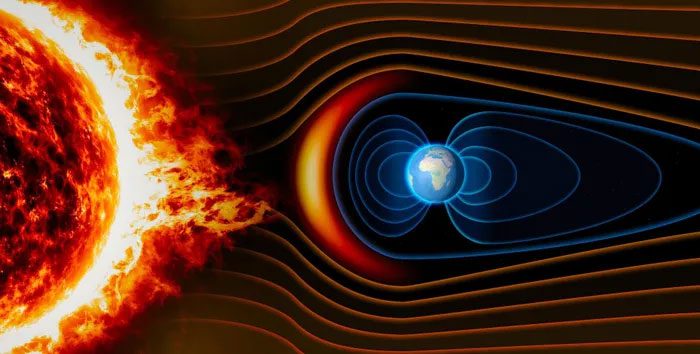Space radiation is a significant concern for NASA in Mars exploration missions. It can damage the brain, increase cancer risk, and lead to cataracts…
The journey to send humans to Mars is far from straightforward. A myriad of challenges can arise when transporting people and supplies into space and landing safely on another planet.
Once they arrive, astronauts will need a safe place to live, air to breathe, water to drink, and food to eat. However, the greatest obstacle to crewed Mars exploration is something invisible: space radiation that can devastate the human body.

This type of space radiation is not like exposure to X-rays during a medical imaging procedure. (Image: Hustler’s Digest).
Cosmic Rays Can Damage the Brain in a Millionth of a Second
While Elon Musk is busy planning a city on Mars, space exploration experts are taking a more cautious approach. After decades of research aboard the International Space Station (ISS), scientists have concluded that microgravity has numerous effects on the body, ranging from vision problems to muscle atrophy.
However, leaving the planet means not just escaping gravity but also departing the atmosphere—the protective shield of Earth. In space, the human body will be exposed to space radiation.
Space radiation comes from two main sources: solar energy activity in the form of sunlight and energetic particles known as cosmic rays.
Cosmic rays are particles, primarily atomic nuclei, but also subatomic particles like protons and electrons. Notably, they travel through space at speeds nearly equal to the speed of light, carrying far more energy than necessary.
“Cosmic rays in the galaxy originate from dying stars. The radiation they carry is a part of the cosmic environment,” explains radiation biologist and radiation expert Eleanor Blakely.

Once outside of Earth, humans will not have the protective atmosphere. (Image: Naeblys).
There are numerous health risks associated with space radiation, yet humanity still does not fully understand them. Scientists believe that space radiation increases cancer risk, affects the central nervous system, accelerates degeneration such as heart disease, cataracts, and alters the immune system.
During space exploration, astronauts are subjected to prolonged exposure to low levels of radiation. This radiation level is markedly different from most radiation found on Earth.
“Most of our data focuses on the effects of radiation such as gamma rays and X-rays on human health.
They damage the body as if you were spraying water from a spray bottle. But cosmic rays move through the body in a straight line, like a rail. Hence, the damage is minimal. However, because it is so small, the body finds it much harder to heal,” explains radiation biologist Greg Nelson, a consultant for NASA.
This type of space radiation is not akin to exposure to X-rays during medical imaging. Instead, imagine a charged particle moving at nearly the speed of light, shooting straight through the brain, disrupting 10,000 cells inside. All this happens in a millionth of a second.
It may not damage those cells, but it activates them in a very unusual manner. Humanity still does not know what this will mean for health.
“This characteristic makes the effects of cosmic rays very unique, unprecedented,” comments Nelson.
The Health Costs of Setting Foot on Mars
Most radiation on Earth can cause cancer by damaging DNA. However, cosmic rays harm the brain in a completely different way, such as disrupting connections between nerve cells or mitochondria within nerve cells.
Another concern is that astronauts are not only exposed to radiation but also face microgravity conditions. This is the cause of health issues like muscle tissue loss since muscles do not have to work against gravity as on Earth.
Moreover, microgravity also restructures the brain. “This means that tissues are activated in a different way than normal, such as changing the ratio of gray matter to white matter. But what are the psychological or physiological consequences? We don’t know,” Blakely admits.
According to NASA’s own calculations, long missions to the red planet could expose astronauts to one dose of radiation (1 Sievert – Sv). This level exceeds the threshold that agencies can tolerate.
By the time humans set foot on Mars, the greatest risk will be radiation during the journey to this planet. Living on the red planet for a month may not have serious effects. However, as the duration increases to 6 months or a year, the changes become more significant. “But we still do not know what this means for the human body,” Nelson says.

Cosmic rays travel at nearly the speed of light, damaging cells in just a millionth of a second. (Image: James Vaughan).
According to The Verge, there are various ways to protect astronauts from radiation, such as shielding. However, this is not a simple task. “Common sense might suggest that just surrounding yourself with lead shielding, using lead-lined clothing, will keep you safe,” Nelson states. But this only holds true for X-rays and gamma rays, especially when radiation comes from one direction. With charged particles coming from all directions, it is not that straightforward.
“For charged particles, they can break apart. Smaller fragments can penetrate deeper than larger ones. Therefore, sometimes adding more shielding can worsen the issue,” Nelson adds.
According to The Verge, NASA has strict limits on the amount of radiation an astronaut can be exposed to over their entire career. “We have to provide an estimated risk level for crew members. After that, they have to decide. Are they willing to accept the trade-off for some benefit—for themselves, for NASA, for the public? Do their families agree with that?” Nelson states.
<pWhether it’s the dream of building a city on Mars or NASA exploring the red planet for months to study the universe, the costs are steep. These costs include not only money and time but also the health and lives of astronauts facing cosmic radiation.





















































